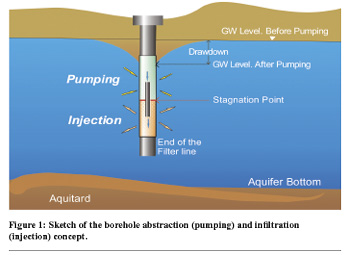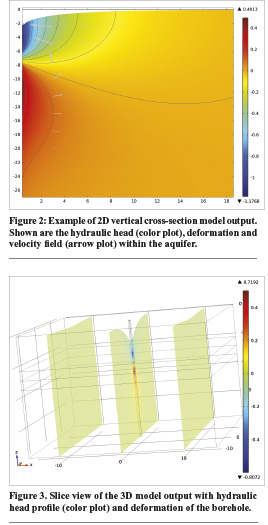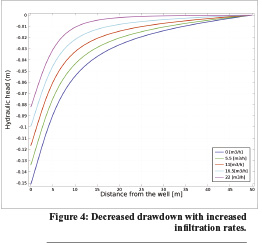Modeling is being used to understand why and how this novel approach works.
Groundwater levels often need to be lowered in order to keep construction or mining sites dry. Known as achieving ‘drawdown,’ the traditional approach is to abstract (pump out) water, and discharge it back into the ground away from the site or into a surface water body. This approach can have a negative impact on the environment.
The local ecosystems at each site are disrupted and subsidence, contamination of ground or surface water, and soil degradation are all potential consequences. In addition, there are the costs of transport and disposal, with increased expenses if water needs to be treated before it can be returned to the ground.
In contrast, ‘Düsensauginfiltration’ (DSI) involves abstraction of groundwater near the groundwater table with injection into the same borehole, but at a greater depth. This avoids the transport of water away from the site as water is not lifted at all, and also has the effect of reducing subsidence.
In effect, the borehole is separated into two parts: the upper part of the borehole is the abstraction section and the lower is the reinjection section. These two parts are usually separated by packers (Figure 1).

Well hydraulics expert Werner Wils, has successfully used this method, also known as JSISWW (Jet Suction Infiltration System Werner Wils) in his company since 2000. It has attracted much attention in Germany and Netherlands, where there are companies licensed to use the system, and is also being used in Vietnam and China. Practical experience shows that it is successful, yet it is not completely understood. It is not clear under which conditions the technology works and in which situations it would not work. The challenge is to examine the technique scientifically and this is being done at the Georg-August-University of Göttingen.
The Department of Applied Geology of the University of Göttingen, led by Prof. Dr. Martin Sauter, concentrates on research in the field of hydrogeology and is cooperating with Hölscher Wasserbau, a leading German dewatering company, within the framework of the DSI project. The project is financially supported by Deutsche Bundesstiftung Umwelt (DBU).
«Our role is to explain why this method achieves results, to understand its advantages and limitations, and identify in which situations it would work best,» comments Assoc. Prof. Dr. Ekkehard Holzbecher, who leads the research team. Yulan Jin, a doctoral student, is responsible for simulation within COMSOL Multiphysics using both 2D and 3D models. She describes the objectives: «We are modeling alongside field experiments that are taking place in Germany so that we can compare results with measured data. We want to accurately predict the response of the system to changing boundary conditions.»
Proving the Basic Principle
A model solving for pressure (or hydraulic head) and the deformation of the aquifer, was set up in 2D, where Figure 2 shows a typical result. As the hydraulic head is lowered at the upper part of the borehole (indicated in blue) it creates a drawdown of the upper boundary, representing the groundwater table. This demonstrates the fundamental principle that drawdown does occur in the aquifer, even if water is injected into the lower part.
The same situation was then modeled in 3D to take into account ambient groundwater flow. The borehole, which is represented as a cylinder, included depth-dependent abstraction or injection rates and were specified as sources and sinks in the mathematical model. In the results for the test case depicted in Figure 3, the same drawdown phenomena as the 2D model were apparent.
«We used the parametric sweep feature in COMSOL Multiphysics to perform an extensive study that focused on different infiltration rates while the abstraction rates were kept constant,» explains Jin. «This enabled us to make a comparison with the classical method where water is pumped out or abstracted and there is no infiltration. We found that when abstraction and infiltration rates are equal, the DSI technology yields half the drawdown rate of the conventional technique of pumping alone. While drawdown still occurs, it is more manageable than if water was removed from the site.» This is illustrated in Figure 4 in which the hydraulic head variation along the groundwater table away from the well is displayed for different infiltration rates.
So far, numerical simulation results show the same trends as measured data from the field. «Simulation is really helping us to see why, how and when DSI works,» says Jin. «For example, we learned that it can only be applied to permeable aquifers, made up mainly of sand and gravel. We have also discovered that sufficient amounts of regional groundwater is critical as it positively affects the rate of infiltration. Moreover, the anisotropy of hydraulic conductivity of the aquifer plays an important role. In particular, it must be considered that as groundwater flow changes with the seasons, it also changes according to the relative conductivity of different layers within an aquifer. One problem is that water injected into the lower part of a borehole may create a local bypass or ‘short-circuit’ within the process. All these situations are examined using our modeling approach.»

Generating Specific Guidelines
One of the DSI application sites is in the immediate vicinity of an abandoned mining site. «We are dealing with a genuine problem as there has been flooding of basements in houses due to the closing of the old mining site,» explains Jin. «Because it is an open aquifer, it is not suitable for conventional dewatering methods anyway because pumping would have to be continuous.»
Jin is adding new parameters to the 3D model as she receives data from the field experiments and this expands the ability of the model to reflect all the real-life variables that may apply. «It is clear that the point at which injection takes place, the size of nozzle, flow rate and corresponding pressure all have to be combined. We are therefore moving towards more complicated, heterogeneous conditions. We are also accounting for several boreholes in one site.»

Having proved that the DSI method works, with some limitations, the university team is now focusing on optimization. Jin concludes: «DSI has many advantages. Yet we know that even when experts with experience use DSI, it can take several days of trial and error to work out where to drill and how many boreholes are required. Through simulation we will be able to produce specific guidelines that will save time and effort on site and enable this method to be taught effectively and replicated successfully.»
(by Jennifer Hand, Co-Authored By Prof. Martin Sauter, Ph.D Student Yulan Jin, And Assoc. Prof. Ekkehard Holzbecher, Georg-August-University)
Source: Comsol News, 2012









